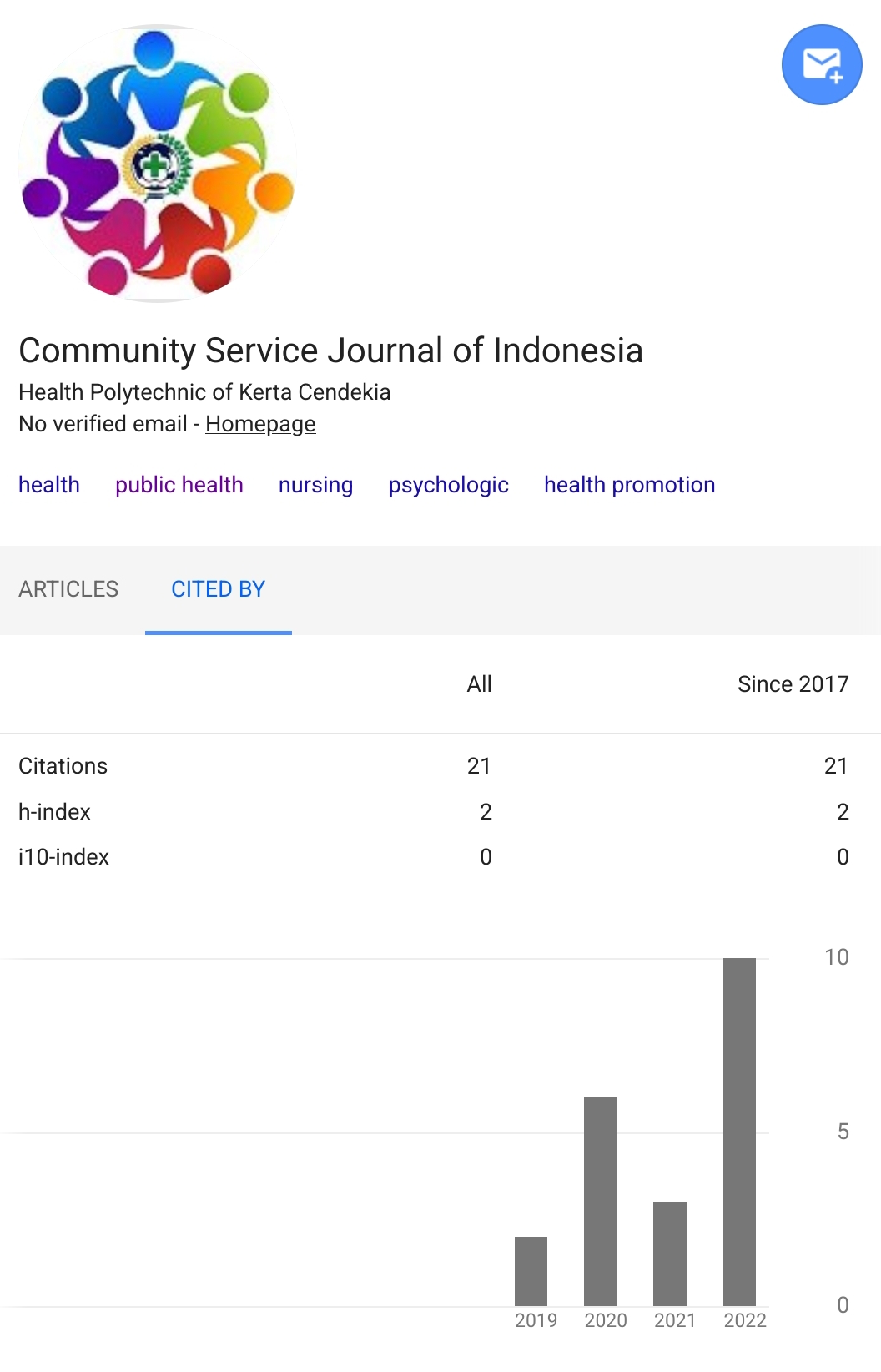IMPROVING HEALTH INFORMATION OF PREGNANT MOTHERS WITH THE ISLAMIC FAMILY APPROACH THROUGH THE RECOGNITION OF ANEMIA SIGNS
Abstract
The most direct cause of maternal death is bleeding. Bleeding is divided into two categories, namely antepartum bleeding (vaginal bleeding at 28 weeks of gestation or more) and postpartum hemorrhage (bleeding that occurs within the first 24 hours after delivery). Bleeding occurs due to lack of supervision and examination during pregnancy, including prevention of anemia. Mothers who suffer from anemia in pregnancy will be very susceptible to infection and bleeding, even if the bleeding is only a little. Experience has shown that maternal death due to bleeding is more common in women who suffer from anemia. Anemia often occurs due to iron deficiency because pregnant women have a twofold increase in iron requirements due to an increase in blood volume without expansion of plasma volume, to meet the needs of the mother (prevent blood loss during childbirth) and fetal growth. Anemia is a condition where the hemoglobin level (>11(gr/L)2), hematocrit (>0.33gr/L), and red blood cell count are below normal values. Anemia in pregnancy is the biggest public health problem that occurs worldwide, especially in developing countries, in low socio-economic groups, and has a very large influence on the quality of human resources. Anemia in pregnancy is called "Potential Danger to Mother and Child" (potentially harmful to mother and child), which contributes to the increasing prevalence of maternal mortality and morbidity. As for infants, it can increase the risk of infant morbidity and mortality, as well as increase the incidence of LBW. Given this, the problem of anemia should be a serious concern for all relevant parties, especially in health services on the front lines. So it is necessary to provide information about anemia signs, namely by providing information and giving Fe tablets, prayers for the good of the mother and fetus, stress management and consumption of green vegetables. Physical and psychological changes are sometimes quite disturbing daily life. Some pregnant women have difficulty regulating emotions because of the changes that occur. Especially the changes in the first trimester of pregnancy. Family support for pregnant women is very important and has many benefits. Not only from husbands, but also from parents, in-laws, sisters, brothers, relatives, or even close friends.References
Dewi Andariya Ningsih. (2015). Partnership Dalam Pelayanan Kebidanan. Proceeding Book.
Emawati., F., Rosmalina., Y., & Herman., S. (2000). Kebutuhan ibu hamil akan tablet besi untuk pencegahan anemia. Bogor: Pusat Penelitian dan Pengembangan Gizi dan Makanan.
Kemenkes. (2013). Profil Kesehatan Indonesia 2012.
Marmi. (2011). Asuhan Kebidanan pada Masa Nifas (Salemba Me).
Ningsih, D. A. (2017). Continuity of Care Kebidanan. OKSITOSIN : Jurnal Ilmiah Kebidanan, 4(2), 67–77. https://doi.org/10.35316/oksitosin.v4i2.362
Ningsih, D. A. (2020). Pengembangan Modul “Peduli Ibu Hamil” Di Desa Sumberejo Banyuputih Situbondo. JOMIS (Journal of Midwifery Science), 4, 55–62.
Ningsih, D. A. (2021a). Midwifery Women Center Care Pada Masa Nifas dalam Buku Asuhan Kebidanan Pada Masa Pandemi Covid-19 (P. Qorinah Estiningtyas Sakilah Adnani, M.Keb & D. R. Pangestuti (eds.)). CV Penulis Cerdas Indonesia.
Ningsih, D. A. (2021b). Penerapan Modul Abah Umi “Mahir Merawat” untuk Deteksi Faktor Resiko BBLR terhadap Pengetahuan Ibu Hamil. Jurnal Ilmu Keperawatan Dan Kebidanan, 12(1), 91–96.
Sandall, J. (2012). Every woman needs a midwife, and some women need a doctor too. Pubmed, 5, 323–326. https://doi.org/10.1111/birt.12010
Schultink, W., Ree, M. van der, Matulessi, P., & Gross, R. (1993). Low compliance with an iron-supplementation program: a study among pregnant women in Jakarta, Indonesia. J Clin Nutr, 57(2), 135–139.
Susiloningtyas, I. (n.d.). Pemberian Zat Besi (Fe) dalam Kehamilan.
Wahyana. (2010). Gizi Reproduksi. Pustaka Rihana.
WHO. (2000). Major nutritional deficiency diseases in emergencis: the management of nutrition major emergencies. Jeneva.
WHO. (2008). Worldwide Prevalence of Anemia .Tersedia :http://whqlibdoc.who.int/publications/20 08/9789241596657eng.pdf. Di unduh 01November 2018.
Winichagoon. (2002). Prevention and control of anemia: Thailand experiences. J Nutr, 132(862S-6S).
Copyright (c) 2022 Dewi Andariya Ningsih, Siti Romlah , Susiana , Umi Nur Kholifah , Tiara Indriani , Silaturrohmih, Siti Hilmi Musyarrofah , Siti Nurhidayati

This work is licensed under a Creative Commons Attribution-NonCommercial 4.0 International License.
Authors who publish with Community Service Journal of Indonesia agree to the following terms:
- Authors retain copyright licensed under a Creative Commons Attribution-NonCommercial 4.0 (CC BY-NC 4.0), which allows others to remix, tweak, and build upon the authors' work non-commercially, and although the others' new works must also acknowledge the authors and be non-commercial, they don't have to license their derivative works on the same terms.
- Authors are permitted and encouraged to post their work online (e.g., in institutional repositories or on their website) prior to and during the submission process, as it can lead to productive exchanges, as well as earlier and greater citation of published work (See The Effect of Open Access). Authors can archive pre-print and post-print or publisher's version/PDF.














